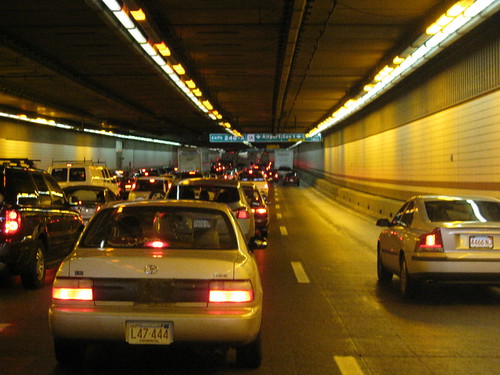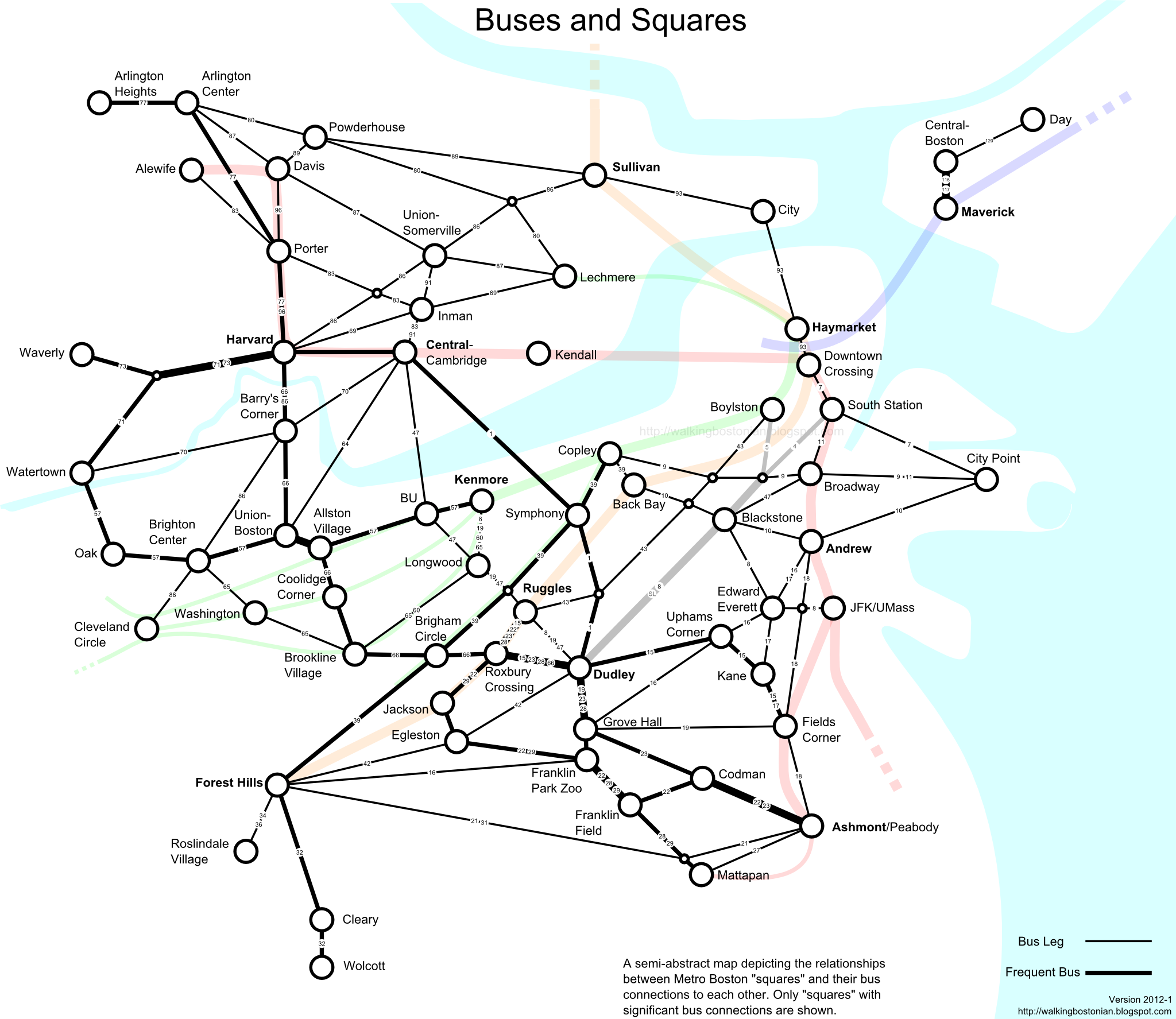 |
| What became of the "crown jewel" of the Emerald Necklace? |
MassDOT held their
Boston Back Bay ramps study meeting today and many folks turned out, filling up the conference room in BPL. The agency framed it as a meeting to discuss several Mass Pike ramp alternatives but the real undertone had to do with the
Bowker Overpass which
many residents are calling to be removed.
It's hard to believe now, but the Charlesgate was once the "
crown jewel" of Frederick Law Olmsted's Emerald Necklace of parks in Boston. In the mid-60s it was covered by the Philip G. Bowker Overpass, in the urban renewal era when it was believed that urban freeways were the key to prosperity and blight elimination. State Senator Bowker was, apparently, the deciding vote in elbowing through the related Storrow Drive plan. Although the notion of building a parkway through the riverfront
Esplanade was
opposed by
both Mr. and Mrs. Storrow, once they had died, elements in the state senate sought to install a major freeway in the parkland area that the Storrows had loved and supported. The first effort failed, but the second effort was held open until they got enough votes to push it through. With the induced traffic on Storrow Drive clamoring to get south to Boylston Street, and the construction of the Mass Pike Extension underway, it is only appropriate that Bowker's name got attached to this overpass.
View Larger Map
Today, the Charlesgate is known as a festering sore on the path between Kenmore and the Back Bay. The overpass is decrepit and falling apart. There have been some emergency repair efforts cluttering up the place from time to time. Below, traffic swarms on the wide avenues running beneath, and coming on and off the ramps at high speed. It is dank and shadowy, a combination of the overpass and the remnants of the trash-strewn Muddy River beneath. Residents complain that they do not feel safe at night walking there. They see bums and junkies hanging out. Although during the day there are enough people who venture there, at night it becomes an empty, secluded space. Even the cars aren't immune from this. While I was walking to the meeting, under the overpass, I saw someone with a can in his hand, walking up and down the ramp, pushing it into windows of the stopped cars, presumably begging for change.
At the meeting, several MassDOT representatives set up a presentation, led by Ned Codd. He introduced project Manager Paul Nelson who was the primary speaker and question fielder. State Rep Marty Walz was also in attendance to support her constituents. Paul began by saying that the project was to look at the possibility of adding some kind of ramp to the Mass Pike in the Back Bay. He also added that they would model the effect on the Bowker Overpass. He presented four alternatives for the ramp, though there was a lot of questioning distributed throughout the presentation. All that information should be posted on the
website shortly. Most of the presentation focused on the results of a study done with a computer model of eastern Massachusetts traffic, extrapolated to the year 2035. The maps were dotted with
level-of-service grades and projected traffic flow changes on the highways.
By the end it was clear that not only were the computer models overly simplistic and unrealistic, they did not even bother to consider the effect any of their plans would have on walking in the area. It simply did not cross their mind. The reaction from the audience was a bit mixed, but vigorous. Representatives from
Friends of the Charlesgate pushed hard for overpass removal. A few residents were concerned that surface traffic might be worse than having the overpass, although it doesn't seem any of them had considered the possibility that traffic levels could be reduced by changing Storrow Drive. Others had more immediate concerns about the proposed ramps and how that might effect them. Or how construction jack-hammering could keep them up all night, a problem that Marty Walz addressed in particular, because MassDOT had caused problems in the past.
Regarding the traffic levels, Paul Nelson actually made an interesting comment, though I'm not sure he has followed it through to its conclusion: "traffic may move [to other roads] but other traffic fills its location." He was referring to the model results for ramps on the Mass Pike, but it seems that it escaped him that his comment also applies to the way widening of roads brings along new traffic, the phenomenon known as "
induced demand."
Fred Salvucci was also there and made some comments supporting the removal of the Bowker Overpass. He suggested that it should simply be shut down, and the effect measured in order to determine what the best course of action was to take after that. It is a waste to pump $11 million in repairs into a bridge like this. Much of the traffic on the Bowker now is headed to Longwood. He pointed out that the Worcester line is going to be upgraded shortly because the state purchased it from CSX, and it will have double-tracking through Brighton and the Back Bay, greatly increasing its capacity. He also pointed out that three-car trains on the Green Line will become more common and that will greatly ease crowding in the trains right now. Both of those offer alternatives for Fenway and Longwood commuters; especially with the new Yawkey station as Marc, the blogger of
Transit On the Line, noted. Fred also pointed to
Octavia Boulevard in San Francisco as a comparable overpass removal project.
Some of the comments from other residents: John S. noted that neither Bowker nor Storrow would be approved today. Don C. asked why there was no alternative without ramps. Sarah F. noted that the Charlesgate was "a really special place" but the overpass is a symbol that cars were the most important thing. Several asked why Storrow Drive was not being included in this analysis. A few years ago, there was a similar effort to start emergency repairs of Storrow Drive, because one of the grade separation tunnels
was falling apart in an unrecoverable way, requiring $300 million in repairs. It has been shored up for the past few years but it will become an issue again soon. Unfortunately, the folks from MassDOT continually refused to consider Storrow Drive alternatives in combination with the Bowker Overpass. They insisted that it would be too big a problem.
 |
| (courtesy: Friends of the Charlesgate) |
But therein lies the key to the whole issue: Storrow and Bowker traffic are inextricably linked. Each justifies the other. But with both of them falling apart, now is the time to reconsider their whole relationship with each other, the surrounding roads, and the surrounding neighborhood. It is time to put Storrow Drive at grade and recover the Esplanade Park for the use of people, instead of it being a hopeless median strip. At the same time, the Mass Pike extension exists now, and should draw off the load that Storrow has been carrying. There is no reason to spend upwards of $300 million in order to repair a road that is being used primarily as a cheapskate bypass of the tollbooths on I-90. And then once the traffic on Storrow goes down, a replacement surface road for Bowker will be much less busy, allowing us to reclaim Charlesgate Park as well. These issues must be solved together, and the refusal of MassDOT to do that seems to be a conscious decision to divide and conquer the community, in order to rebuild the highways exactly the same way they were built in the 50s and 60s. This attitude favors the suburban commuters, at terrible expense to the taxpayer, and to the detriment of the city residents.
I spoke with Project Manager Paul Nelson briefly after the meeting. He seems young, and a bit earnest. The issue I had in mind was that I have long been upset by the lack of a pedestrian walk phase on Charlesgate West at Comm Ave. Technically, there is no legal or safe way to cross that on-ramp to the Bowker Overpass. Thousands of people do it every day, since it is one of the only ways to get between Kenmore and the Back Bay. I often see people getting confused, or just dodging between cars to cross it. I asked Paul if, for the time being, he could take a look at fixing that situation in the short term. He was confused, and didn't know the place I was talking about. I said "you know, next to the comic shop." He then revealed that he "was new and unfamiliar with the area." Then he asked me "there is not even a [signal] head?" and I nodded, going on to say, "there's two phases: don't walk, and don't walk because there's a turn signal arrow directing cars across your path." He agreed to look into it.
That's where we're at. The MassDOT project manager is unfamiliar with the territory his work will affect. The rest of us are all too familiar with what it's like under there.
Related:
On the McCarthy Overpass meeting in Somerville.


















